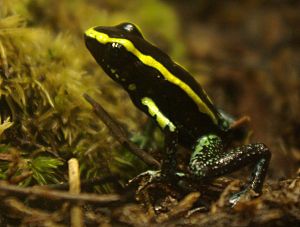Phyllobates aurotaenia facts for kids
Quick facts for kids Phyllobates aurotaenia |
|
|---|---|
 |
|
| Conservation status | |
| Scientific classification | |
| Synonyms | |
|
Dendrobates aurotaenia Boulenger, 1913 |
The Phyllobates aurotaenia, also known as the Kokoe poison dart frog, is a small, brightly colored frog. It belongs to the frog family Dendrobatidae, which are often called poison dart frogs. These frogs live in warm, wet places in Central and South America.
This frog was first described by a scientist named George Albert Boulenger in 1913. The Kokoe frog is famous for being one of the most poisonous frogs in the world. It is the smallest of the poison dart frogs in its group, called Phyllobates. You can only find this frog along the Pacific coast of Colombia.
Wild Kokoe frogs have a strong poison called batrachotoxin in their skin. Just a tiny bit of this poison can be very dangerous to humans. Some Native American groups in Colombia have used this unique poison for hunting for a long time.
Kokoe frogs are easy to spot because of their colors. They have black backs, sometimes with orange patches. They also have bright green, yellow, orange, or brownish-gold stripes along their sides. Their bellies are black with blue or green dots. There are two main types of Phyllobates aurotaenia: a smaller one with wide stripes and a larger one with thin stripes. Even though they live in different areas, they can still have babies together.
Sadly, the number of Kokoe frogs is going down. This is mainly because their homes are being destroyed. However, the IUCN (a group that checks on animals) currently lists them as "Least Concern." This means they are not in immediate danger of disappearing.
Contents
Where Kokoe Frogs Live
The Kokoe poison dart frog lives in the wet forests of the Chocó region of Colombia. This area is west of the Andes mountains. You can find them near the Atrato and San Juan rivers.
These frogs live on the ground in humid forests. They prefer both old, untouched forests and forests that are growing back. You won't find them in areas where the forest has been badly damaged. They usually live at heights between 60 and 520 meters above sea level.
If you were to keep a Kokoe frog as a pet, you would see it is very active. It likes to climb and use all the space in its tank. These frogs are social and need a lot of moisture, cool temperatures, and bigger food than many other dart frogs.
Kokoe Frog Reproduction
When male Kokoe frogs want to find a mate, they make special calls. They usually hide under fallen leaves or logs when they call. Sometimes, they will sit on top of the leaves. Their calls sound like a loud, bird-like whirring or twittering sound. They repeat these notes quickly for up to 45 seconds, with short breaks in between.
Unlike some other dart frogs, Kokoe frogs do not fight each other physically. If two males want the same female, they will face each other and call loudly. The one who calls less or backs down first loses.
These frogs are different from other Phyllobates species because they don't lay their eggs in coconut shells. Instead, they prefer to lay their eggs inside a narrow tube. This could be a small film canister or a hollow nut pod on the ground. A female Kokoe frog lays about 15 to 20 eggs at a time. After the eggs hatch, the male frog carries the tiny tadpoles to slow-moving water.
How Kokoe Frogs Use Poison
The Kokoe frog is one of the most dangerous poison dart frogs. This is because they store and release a powerful poison called batrachotoxin from glands in their skin. This toxin is very strong. In mammals, like humans, it makes nerve and muscle cells stop working. This causes paralysis and can even lead to death. The frog's own body has special cells that are not affected by the poison, so it doesn't hurt itself.
Interestingly, Kokoe frogs raised in zoos or special homes are usually not poisonous. This suggests that the frogs do not make the poison themselves. Instead, they get it from what they eat in their natural environment. Scientists believe they get the toxin from certain beetles, millipedes, and flies. The unique types of leaves on the forest floor might also play a role.
Value to People
The Kokoe frog is one of only three frog species known to be used by people for poisoning darts. The other two are P. terribilis and P. bicolor. The Chocó Native Americans, who live near the San Juan river in Colombia, know how to attract and catch these frogs by copying their calls.
The frogs only release their poison when they are stressed. To get the poison, the Chocóan people carefully hold the frogs over a fire. This makes the frogs release the poison onto their skin. Then, they rub their hunting darts across the frogs' backs to coat them with the poison.
See also
 In Spanish: Phyllobates aurotaenia para niños
In Spanish: Phyllobates aurotaenia para niños


